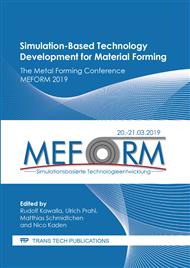p.1
p.7
p.15
p.24
p.32
p.40
p.48
p.57
p.66
A Numerical Model for the Prediction of Microstructure Distribution across the Thickness of Quenched Steel Plates
Abstract:
In this work we apply a numerical inverse analysis procedure based on the ICME framework to ensure a required microstructure and combination of properties in the quenched plate. The microstructure is decided first, and the cooling profile needed to obtain such microstructure is then calculated using the CALPHAD approach. Subsequently, an inverse analysis of the heat transfer problem provides the description of the convection mechanism in quenching that results in the demanded cooling profile. An additional constraint is set on the through-thickness thermal gradient to achieve a homogeneous microstructure. Finally, the resultant microstructure is computed. By means of the proposed model we are able to retrieve the necessary quenching process parameters and to quantify the influence of these parameters on the temperature and microstructure distribution within the plate after the quenching.
Info:
Periodical:
Pages:
32-39
Citation:
Online since:
March 2019
Permissions:
Share:
Citation:


